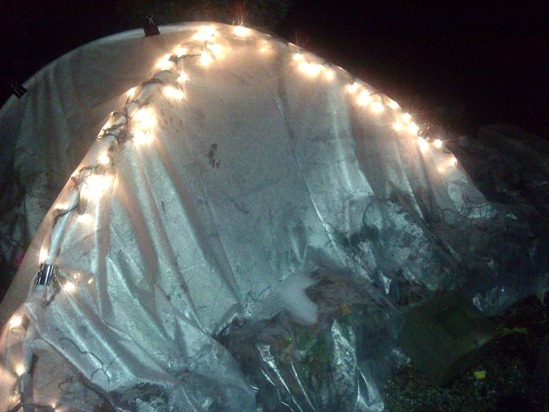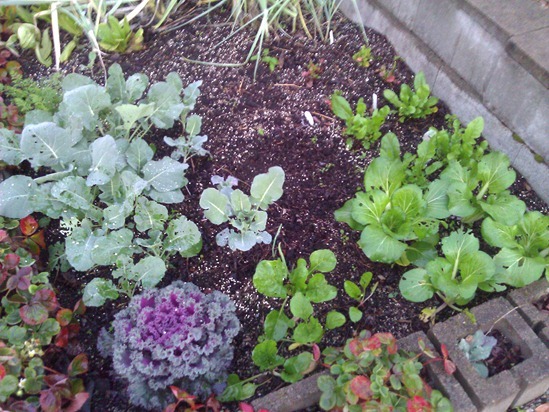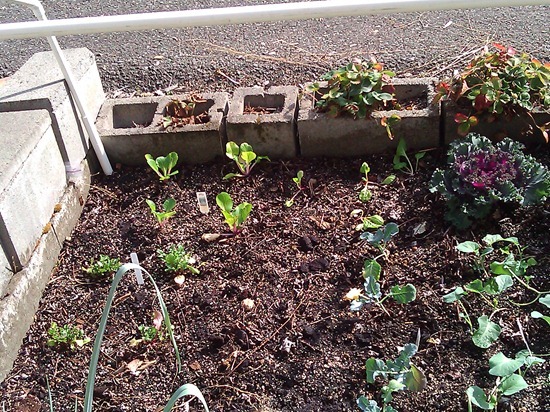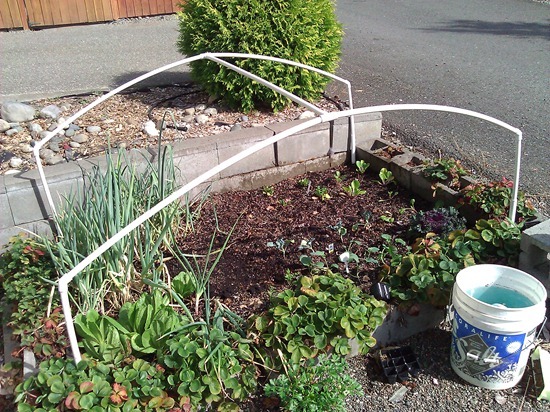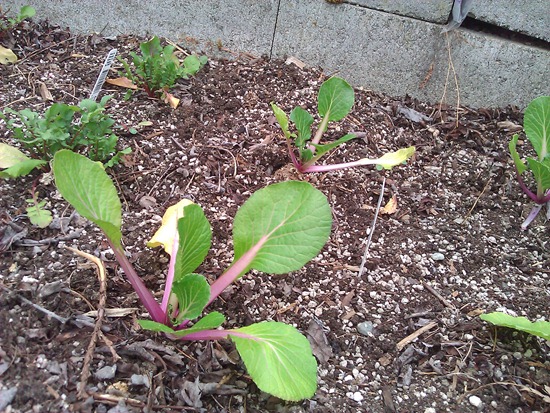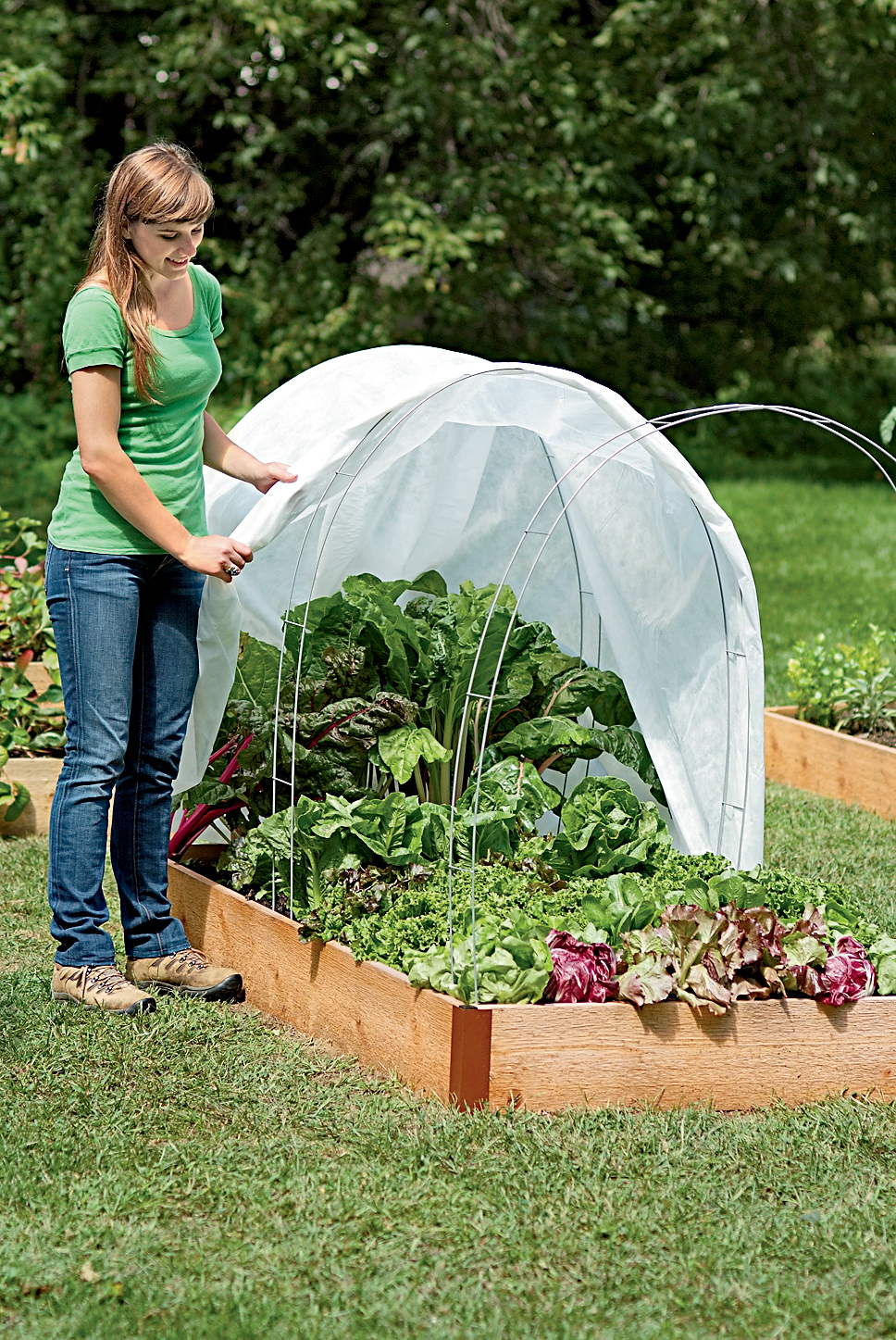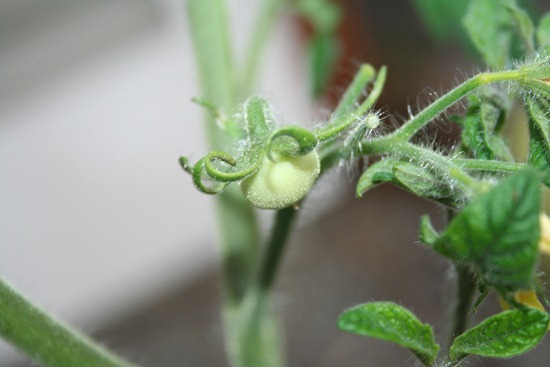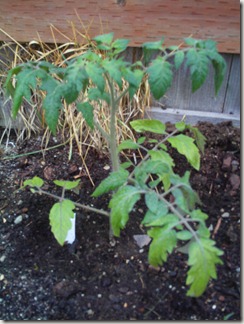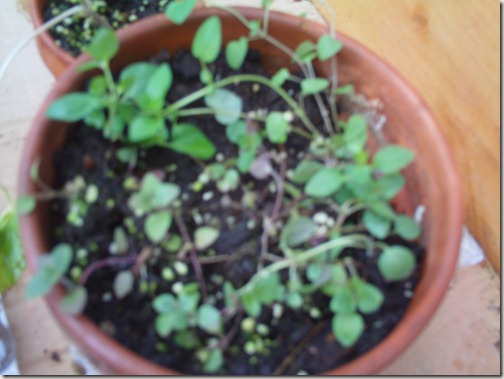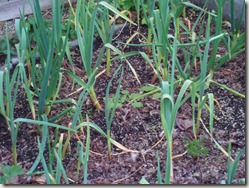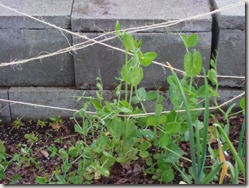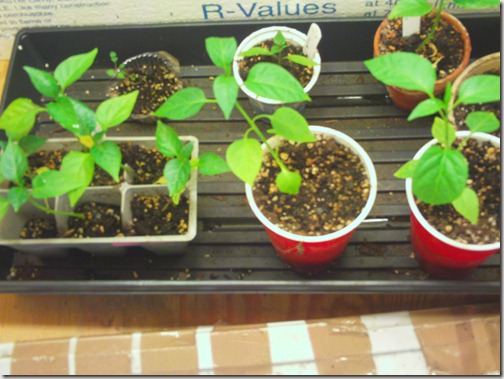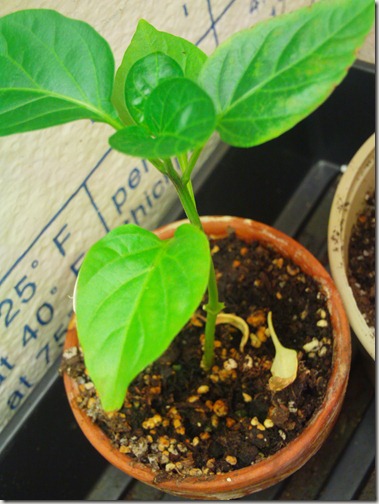Cheap hoop house heating
12.3 years ago cold season crops, outdoor seed starting, winter garden
Before you put those Christmas lights away into storage you may want to keep a couple strings (non-LED) set aside to use for heating a hoop house. These little lights can help boost the temperature 5-10 degrees inside your enclosure, while this will not allow you to grow tomatoes and peppers during the wintertime. This may be enough to allow you to keep a winter garden for the whole winter and/or provide just enough warmth to bring out your spring seedlings a couple weeks earlier.
Quick winter garden update
12.5 years ago bok choy, broccoli, cold season crops, garlic bulbs, winter garden
The weather is starting to get colder (yesterday woke up to 37F) but still in safe ranges for my winter garden which is doing great. An abundance of Kale and arugula and chard and bok choy are getting pretty close to harvest. Broccoli is taking its time like it should.
I also planted some chives, onions which I started from seeds several week ago. I have also planted a bulb worth of garlic to harvest next summer.
What I am growing in my winter garden
12.6 years ago bok choy, cold season crops, garlic bulbs, leeks, lettuce, onions, winter garden
I normally get burned out over the spring/fall and don’t do much for the fall/winter season. This year I decided I want to have a nice selection of winter veggies so I am going all out and start my winter garden.
In the garden now are kale, broccoli, bok choy, carrots, spinach, romaine lettuce, arugula (one of the most profitable vegetables), bunching onions, garlic, and leeks. I wanted to grow Brussel sprouts but I should have started those about 4 month ago.
I grew the lettuce, broccoli, onions, and leeks from seeds in the grow box and transplanted them a few of weeks ago. The bok choy, kale, and arugula were an impulse addition when I saw the plants on sale and struggling at my local grocery store.
All of these plants should do pretty well with the mild winters we get here in the Pacific Northwest…but our hard rains and occasional snowfall could lead to their downfall. For this reason I came up with this structure which when the rains and/or low temperatures come I will cover with 2.5mm plastic sheeting. Though I plan on adding one more set of cross pieces to prevent sagging in the middle, I consider this design a bit of a hybrid between row covers and a full blown hoop house.
This will provide plenty of space for the plants to grow and ease of getting under the structure to harvest in the rain while not large enough to hopefully not catch a little wind and sail away.
I am excited to continue to collect my harvests all year round.
How to start a winter vegetable garden
12.6 years ago broccoli, cold season crops, fall crops, freezing, leeks, lettuce, onions, spinach, winter garden
Why let your gardening season end, with a little creativity there are many vegetables that can continue growing right through winter. I find this fun as wells of a rewarding challenge bringing in some great produce from my garden all year round.
Choosing your winter vegetables
First we need to determine what vegetables to grow, given temperature and lack of light will be a reality we will have to go with the colder tolerate spring/fall options. below are some of my favorites and their typical hardy temperatures.
Arugula: Hardy up to 15F (-9C). Not only is this the most profitable vegetable to grow per square foot it is a tasty and nutritious addition to your garden salads a very good source of vitamin A/C/K, folate, calcium, iron, magnesium, phosphorus, potassium and manganese.
Beets: Hardy up to 20F (-7C). With beets you have a couple of options, eat the roots which are an excellent source of folate, potassium and manganese. The other option is to eats the beet greens which are an excellent source of vitamin A/C/E/K/B6, thiamin, riboflavin, calcium, iron, magnesium, potassium, copper and manganese
Bok choy: Hardy up to 24F (-4C). Bok choy is a great source of vitamin A/C/K/B6, riboflavin, folate, calcium, iron, magnesium, potassium and manganese.
Broccoli: Hardy up to 10F (-12C). So many options here and great eat fresh and if you get too much at once it is easy to freeze your excess crops while being a great source of Vitamin A/C/K/B6, folate, potassium and manganese.
Brussels Sprouts: Hardy up to 0F (-16C). If the thought of Brussels sprouts sicken you, don’t give up on these until you try some fresh from your garden. As an added bonus this is a great source of vitamin A/C/K/B6, thiamin, folate, potassium and manganese.
Cabbage (Winter): Hardy up to 5F (-14C). Use for raw for coleslaws or cooked in stews or soups to add some vitamin C, folate, potassium and manganese to your next meal.
Carrots: Hardy up to 15F (-9C). Great in salads, stir-fry, or raw as a quick snack and is also a great source of Vitamin A/C/K and potassium
Collards: Hardy up to 24F (-4C). Great sautéed with a little oil with salt and pepper and a great source of vitamin A/C/E/K/B6, riboflavin, folate, calcium and manganese.
Endive: Hardy up to 5F (-15C). Great addition to salads as well as making or a great addition to sounds. Endive is high in vitamin A/C/K, thiamin, riboflavin, folate, pantothenic acid, calcium, iron, potassium, zinc, copper and manganese.
Kale: Hardy up to 8F (-13C). Sauté as a great side or even bake to make some delicious Kale chips and is high in vitamin A/C/K/B6, calcium, potassium, copper and manganese.
Kohlrabi: Hardy up to 15F (-9C). The taste and texture of kohlrabi are similar to those of a broccoli stem or cabbage heart, but milder and sweeter, with a higher ratio of flesh to skin. The young stem in particular can be as crisp and juicy as an apple, although much less sweet1. Kohlrabi is a great source of vitamin C/B6, potassium, copper and manganese
Garlic: Hardy up to 8F (-13C). One of the most useful aromatics to use in your kitchen and high in vitamin C/B6 and Manganese.
Leeks: Hardy up to 8F (-13C). Great additions/bases for many soups and stocks. Has flavor of onion though not quite as overpowering. It is also a great source of vitamin A/C/K, folate and manganese.
Lettuce: Hardy up to 24F (-4C). Staple for a quick winter salad. Choose varieties with darker leaves for more nutritious goodness of vitamin A/C/K, thiamin, folate, iron, potassium and manganese.
Onions (Bulb): Hardy up to 0F (-18C). Plant these out this fall/winter for some nice large bulbs next spring summer. These provide a great deal of versatility and vitamin B6, folate, potassium and manganese, and a very good source of Vitamin C.
Onions (Bunching): Hardy up to 10F (-12C). Plant a bunch of these and your garden and they will continue to spread and provide additional produce to your kitchen. With just a little bit of protection you can have onions all winter.
Peas: Hardy up to 35F (2C). Can be shelled and cooked and eaten as is or added to some nice soups in the wintertime or kept in the shells and eat raw or a great addition to a nice stir-fry. Peas also provide vitamin A/C/K, thiamin, folate, iron and manganese.
Spinach: Hardy up to 8F (-13C). Just recently got turned back to eating spinach, previously just used in an occasional salad but now I add to omelets every morning for some great taste but are also packed with nutritional potency being a very good source of protein, vitamin A/C/E/K/B6, thiamin, riboflavin, folate, calcium, iron, magnesium, phosphorus, potassium, copper and manganese.
Swiss Chard: Hardy up to 20F (-7C). Vitamin A, Vitamin C, Vitamin E (Alpha Tocopherol), Vitamin K, Riboflavin, Vitamin B6, Calcium, Iron, Magnesium, Phosphorus, Potassium, Copper and Manganese.
When can you actually grow these vegetables
Now that found the vegetables you want to grow now is a good time to check those hardy temperatures of the vegetables you have chosen compared to your average winter temperatures. If your average low for the day is going to fall at or below that limit you may want to consider skipping that one or invest in a little protection.
Using a site like WeatherSpark, you can determine what your average low is for your area and then determine what vegetables you can grow during the winter. As you can see above on average in my area the average low is 36F which allows me to grow most of the cold season vegetables mentioned above. Though it is possible to get an occasional cold streak which cold mean death to my vegetables over the winter.
By using some row covers you can provide a little extra temperature (5-10F) depending on the thickness of the plastic and the volume of air you are attempting to keep warm. The thicker the plastic the better the temperature retention though allows less light to get through. For my area I am going with 2.5mm which should provide some decent protection while still allowing needed light in. When things really go bad you can also supplement with a light blanket at night and/or a couple strings of regular old Christmas lights (no LEDs for this application) to provide a few more degrees.
How to start your vegetables
Though your plants may grow well in the low temperatures germination can be incredibly slow at lower temperatures even for cold weather plants. For this reason you should start your vegetables indoors and bring them outdoors with some minimal hardening off.
As a general rule here are the plants you should be able to start as seeds in the ground now (September):
- Carrots
- Garlic
- Lettuce
- Onions (sets for green onions, seeds for spring onions)
- Radishes
- Spinach
Other plants should be started indoors and planted out as starts. These can be brought out right now so check you local grocery store…this time of year I have found 4-packs of winter vegetable starts as low as $0.25 as the stores are making room for the Halloween pumpkins coming in. Since you will want a continuous harvest you can also start seeds now and every few weeks for a constant supply of winter vegetables all winter long.
Summing things up
By taking maturing and harvest time into account and creating continual planting you should supply yourself with delicious and nutritious selection of vegetables all winter long. I was going to go into what I am growing this year…but this post is already getting long so will write about that later…
First tomato appeared in the grow box
13 years ago cold season crops, tomato
I noticed a tiny tomato starting on one my plants growing in my computerized grow box under 120 watt LEDs grow lights. Given our lower than average temperatures here in the Pacific Northwest this year (lows averaging in the low 40s) not sure if these plants will ever make it outside…
Even though I was somewhat pessimistic for my seed starting times and facing the difficult decision:
1. Keep them in the grow box where they risk becoming root bound and limited vertical space to grow
2. Let them go outside and be challenged by the poor growing environments
I do have some ideas to help make this decision easier, but I have some experimenting to do and will post on that later with accompanying photos…
Earth Day in the garden
14 years ago cilantro, cold season crops, garlic bulbs, onions, peppers, tomato
I decided to take the day off to catch up on some things at home and as I ended up outside of course I went right to the garden.
We have seen a few warm days here in the Northwest and in my area we haven’t dipped under 40 degrees at night so seemed like a good time to plant a few of my tomatoes spending their time this winter in the grow box.
Above are a New Yorker and Persey both of which are new for me this year. They have been growing great even with my neglect during their youth. I also have some Green Zebras, Husky Cherry, Sweetie Cherry, and Yellow Cherry. I did attempt Red Brandywine but the seeds I got appear to be duds.
Given it is always good to have a Plan B so I have twins of these tomato plants still in puts which I can bring if a cold snap comes and kills off the plants I ambitiously planted in the ground.
Elsewhere in the garden I have some herbs: Parsley and Oregano, with Basil being an unfortunately casualty which I will plan on buying from the store and try again next year.
Next I checked out my larger garden bed to see my peas, cilantro, onions, carrots, lettuce, strawberries and garlic
Lastly I checked out the peppers in the grow box which they will stay until we have some warmer nights (at least 50 degrees) otherwise can cause significant stunting of growth. So until then they will remain happy in the grow box and given they are still pretty small, still plenty of room to grow…
Tags: cheap, cilantro, garden seeds, garlic bulbs, growbox, herb garden, outdoor plants, pepper plants, strawberry plants, tomato plants, vegetables
